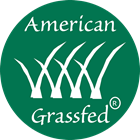Grassfed meat has a different texture, flavor, and nutritional profile than so-called conventional meat.
Because most Americans living today learned how to cook with meat from animals treated with hormones to
develop unbalanced physical attributes, fed unnatural, unhealthy diets in confined animal feeding
operations or feedlots and then treated with antibiotics to address diseases that arise as a result of their living conditions, switching to pasture-based, grassfed meat takes some getting used to.
But you already know why pasture-based, grassfed meat is better for you, your community, and your environment. Here are some tips to help you learn how to cook grassfed meat to get the most flavor and tenderness.
How To Buy Grassfed Meat
Until there are transparent labeling practices in place, we recommend buying AGA-certified products from your grocer or direct from the farmer or rancher. If that’s not possible where you live, find a regenerative, pasture-based operation near you and learn about their operation. Then, if they’re not AGA members, send them our way!
How To Cook Grassfed Meat
Many of us prefer to purchase so-called fresh cuts over frozen meat. That’s because almost none of us ever learn how to properly thaw frozen meat.
Meat frozen immediately after processing and kept frozen until you chose to prepare it is actually fresher than cuts that are kept at varying levels of refrigeration for days or weeks, treated with coloring to preserve the look of freshness and sold ready-to-cook.
How To Thaw Frozen Grassfed Meat
Tip No. 1: Place frozen meat in a bowl or container in the refrigerator for 12-24 hours. As the meat thaws it will release water and proteins that you don’t want running out in your fridge.
Again, if the meat was frozen immediately after the animal was processed and kept frozen until you put it in your refrigerator, after 24 hours that meat is now a little over one day “old,” much fresher than what you will get from conventional grocers’ cooler.
If you want to thaw the meat more quickly, place the vacuum-sealed package in cold water for several minutes.
Do not let meat sit at room temperature for no more than 30 minutes, cook it cold straight from the refrigerator, or use a microwave to thaw grassfed meat.
How To Tenderize Grassfed Meat
Tip No. 2: Animals that are allowed to eat natural diets and express instinctive behavior on pasture produce meat that is less tender than so-called conventional meat. Tenderizing your meat before cooking breaks down any tough connective tissue produced by the animal’s healthy life.
We recommend using a mechanical tenderizer like the Jaccard. It’s a small, hand-held device with needles-like blades that pierce the meat and allow a marinade or rub to penetrate the surface.
Another way to tenderize is to coat a thawed steak with your favorite rub; put it into a plastic zipper bag; place on a solid surface; and, using a meat mallet, rolling pin, or other hard object; pound a few times. This will not only tenderize the meat, but will also incorporate the rub, adding flavor. Do not flatten the beef unless the recipe calls for it.
How To Prepare Grassfed Meat
Tip No. 3: Grassfed beef is ideal at rare to medium-rare temperatures. If you prefer meat well done, cook at a low temperature in a sauce to add moisture. A slow cooker is ideal.
Tip No. 4: Because grassfed beef is low in fat, coat it with extra virgin olive oil or another light oil for easy browning. The oil will also prevent the meat from drying out and sticking to the cooking surface.
Tip No. 5: Very lean cuts like New York strips and sirloin steaks can benefit from a marinade. Choose a recipe that doesn’t mask the flavor of the beef but will enhance the moisture content. For safe handling, always marinate in the refrigerator.
Tip No. 6: Grassfed beef cooks about 30 percent faster than grain fed beef. Use a thermometer to test for doneness and watch the temperature carefully. You can go from perfectly cooked to overdone in less than a minute. The meat will continue to cook after you remove it from the heat, so when it reaches a temperature ten degrees LOWER than the desired temperature, it’s done.
Tip No. 7: Sear the beef first when roasting to lock in the juices and then place in a pre-heated oven. Reduce the roasting temperature by 50 degrees F.
Tip No. 8: When grilling, quickly sear the meat over high heat on each side and then reduce the heat to medium or low to finish. Baste to add moisture.
Tip No. 9: When grilling burgers, use caramelized onions or roasted peppers to add low-fat moisture to the meat.
Tip No. 10: Pan searing on the stove is an easy way to cook a grassfed steak. After you’ve seared the steak over high heat, turn the heat to low and add butter and garlic to the pan to finish cooking.
Tip No. 11: Never use a fork to turn meat. Always use tongs.
Tip No. 12: Let the beef sit covered in a warm place for eight to 10 minutes after removing from heat to let the juices redistribute.
Now you’re ready to make the switch and we’d love to see what you make! Try one (or all) of the recipes here and share your photos with us on Instagram, Facebook, and Twitter.
If you believe in regenerating America’s physical health, rural economy and ecology, please consider supporting American Grassfed by becoming a member or donating.
